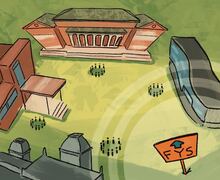Sam Van Aken talks making tree with 40 fruits, writing book about grafting trees
Courtesy of Josh Feinblatt
At his sanctuary, next to the Comstock Art Building, Sam Van Aken is grafting around 75 trees.
Syracuse University professor Sam Van Aken attracted national attention when National Geographic featured him for creating hybrid trees that hold up to 40 different types of fruits. The School of Visual and Performing Art professor’s story went viral this summer, getting picked up by news outlets across the country.
Now, he is writing a book chronicling the process used to mix different types of trees, a process called grafting. At his sanctuary, right next to the Comstock Art Building, he is currently grafting around 75 trees. While it may seem like only a genetic engineer could be able to create a hybrid tree with 40 fruits, professor Van Aken does not consider himself a scientist. He took some time from creating Frankenstein-esque trees to sit down with The Daily Orange to talk about the grafting process and how he came up with the idea.
The Daily Orange: How did you come up for the idea for these 40 fruit trees?
Sam Van Aken: I became interested in it as a metaphor. The project probably started about 10 years ago combining two pieces of plastic fruit, just playing around in the studio, and eventually it was the notion of, “How can I make this real?” So, the aim of the project at first was to have this tree to blossom with all of these different colors that would produce all these different fruits, so that when people would happen upon it, they would have this moment of rethinking. Gradually the project evolved, and I realized a lot about how fruit was being grown and produced in the country. New York was the largest producer of plums in the country back in the early 20 century, and that industry had pretty much disappeared. So, then the project almost became a form of preservation of these heirloom and antique varieties [of stone fruits].
The D.O.: What is grafting, and can you explain the process?
S.V.A.: I do it two times a year: Once in the spring right before the tree blossoms and once in August. It’s two different types of grafting. I’ll go out in February and prune these and bag them and store them until April. It’s actually pretty simple, I cut a harsh diagonal line on the tree, cut a diagonal line on that variety I collected and just stick them together. You use electrical tape, and what you’re trying to do is match up the cambium layer of the branch. Right underneath the bark is the cambium layer where all of the nutrients for the tree flow. The other type of grafting that I’ll do is called chip grafting. So what I’ll do, and this is in August, you take a small sliver of a tree, and that small sliver will include a bud on it. You insert that small sliver into the tree and you just tape it. What it does is create a tiny little greenhouse with high humidity. I’ll come back in spring, right before blossom, and I’ll prune that tree right above that graft, and it forces the tree to think it’s its own fruit.
The D.O.: How long have people been grafting?
S.V.A.: It’s been going on for thousands and thousands of years. There’s actually records of [ancient] Egyptians grafting using leather as the binder that holds the two things together.
The D.O.: Why choose to plant the first 40 fruit tree on the Quad?
SA: I was approached by Hendricks Chapel to develop a piece that would commemorate Sept. 11. That day was so tragic that it was impossible to develop a piece for it. I talked to the Dean of Hendricks at the time and said, “What do you think about this tree of 40 fruit?” And they really liked the idea, so we went around to some sites and the quad made the most sense for it.
The D.O.: A lot of people have heard about the tree but not many people know where it is, even though it’s right out in the open. Why not make a big deal out of it or have a huge sign where it is?
SA: That was the initial aim of the work — to have people happen upon it as opposed to having a big announcement that says “This is the tree.” It’s almost one of those things that, if you stop and notice, you’ll get something from it.
Published on November 4, 2015 at 10:19 pm
Contact Josh: jfeinbla@syr.edu





